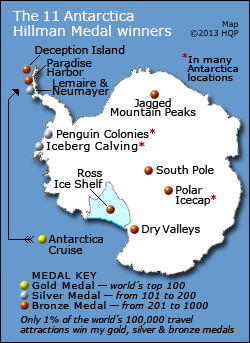Penguin Colonies
 Why
penguin colonies
in Antarctica
are special
Why
penguin colonies
in Antarctica
are specialMillions of penguins annually return to their ancestral Antarctica colonies to rear their young. Some Antarctica colonies have hundreds of thousands of penguins.
About Emperor Penguin colonies
The most interesting of all
All penguin colonies fascinate, but the unique breeding behavior of the emperor penguin species in Antarctica captures the imagination.
-
Female's role
Unlike other penguin species, the emperor penguin female lays only one egg per year. After doing so, she gives the egg to her mate, and then slowly waddle-walks upwards of 50 kilometers (30 miles) to the sea to feed. - Male's role
Meanwhile, the male incubates the egg by himself. To keep the egg warm, he cradles it on his feet and blankets it with his special abdomen skin fold. He also preserves heat by closely huddling with his fellow egg cradlers. He does this for nine weeks. - Female comes back
The female returns to take over at hatching. She begins the rearing process while the hungry male departs for the sea to eat (which he hasn't done in over 2 months). - Shared parenthood
Once fed, he returns. And the incubation cycle continues. When the chick hatches, the parents more or less rotate the rearing and sea-feeding necessities until the chick is old enough to go to the sea and fend for itself.
They are birds but they cannot fly. They walk on land, but in a comical way. However, penguins are elegant and speedy in the water - some exceed 30 kilometers (20 miles) per hour.
Diving depth
Emperor penguins can dive to a depth of over 500 meters (1600 feet) - and can remain underwater for 20 minutes.
Food
Penguins feed on fish, krill, shrimp and squid in the sea surrounding Antarctica - while leopard seals and killer whales feed on the penguin.
Southerners
Penguins exist in the wild only in the southern hemisphere.
Lifespan attributes
Penguins mate for life and some penguins live for decades.
Lengthy migrations
Like salmon, penguins travel great distances to return to breed at the exact location where they were born. Only the emperor penguin lives year-round in Antarctica. The others migrate in winter to slightly warmer latitudes.
Sex indication
It's difficult for the untrained human eye to tell the male from the female penguins.
Largest penguin
The emperor penguin is the largest of the penguin species (about the height and weight of a heavyset six-year-old boy).
Evolution
It engineered penguins for keeping warm in their frigid Antarctica environment by giving them compact waterproof feathers and a blubber layer under the skin. Evolution also provided them with a relatively high body mass to skin area ratio - and a unique physiological system that minimizes body heat loss during breathing.
Keep alert in the colonies
Penguins are adorable, but watch where you step while exploring their colonies. They can create quite a mess - and stench (which increases with the temperature). And, if you come too close, some might snap at your legs with their sharp avian beaks.
Location in Antarctica



